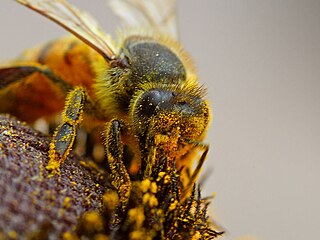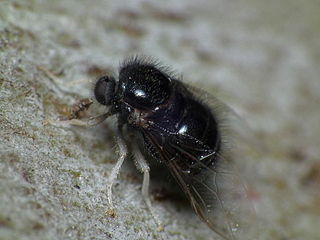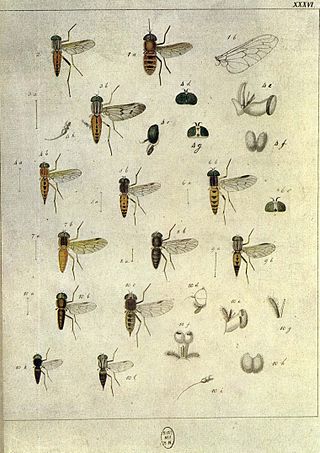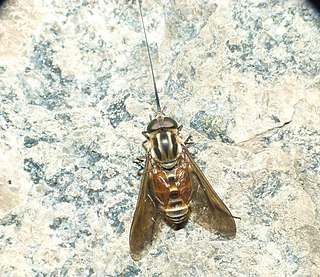
Mosquitoes are approximately 3,600 species of small flies comprising the family Culicidae. The word "mosquito" is Spanish for "little fly". Mosquitoes have a slender segmented body, one pair of wings, one pair of halteres, three pairs of long hair-like legs, and elongated mouthparts.

Butterflies (Rhopalocera) are insects that have large, often brightly coloured wings, and a conspicuous, fluttering flight. The group comprises the superfamilies Hedyloidea and Papilionoidea. The oldest butterfly fossils have been dated to the Paleocene, about 56 million years ago, though they may have originated earlier.

Lepidoptera is an order of insects that includes butterflies and moths. About 180,000 species of the Lepidoptera have been described, representing ten percent of the total described species of living organisms, and placed in 126 families and 46 superfamilies. It is one of the most widespread and widely recognizable insect orders in the world. The Lepidoptera show many variations of the basic body structure that have evolved to gain advantages in lifestyle and distribution. Recent estimates suggest the order may have more species than earlier thought, and is among the four most species-rich orders, along with the Hymenoptera, Diptera, and Coleoptera.

Flies are insects of the order Diptera, the name being derived from the Greek δι- di- "two", and πτερόν pteron "wing". Insects of this order use only a single pair of wings to fly, the hindwings having evolved into advanced mechanosensory organs known as halteres, which act as high-speed sensors of rotational movement and allow dipterans to perform advanced aerobatics. Diptera is a large order containing an estimated 1,000,000 species including horse-flies, crane flies, hoverflies, mosquitoes and others, although only about 125,000 species have been described.

Hummingbirds are birds native to the Americas and comprise the biological family Trochilidae. With about 366 species and 113 genera, they occur from Alaska to Tierra del Fuego, but most species are found in Central and South America. About 28 hummingbird species are listed as endangered or critically endangered, with numerous species declining in population.

Hover flies, also called flower flies or syrphid flies, make up the insect family Syrphidae. As their common name suggests, they are often seen hovering or nectaring at flowers; the adults of many species feed mainly on nectar and pollen, while the larvae (maggots) eat a wide range of foods. In some species, the larvae are saprotrophs, eating decaying plant and animal matter in the soil or in ponds and streams. In other species, the larvae are insectivores and prey on aphids, thrips, and other plant-sucking insects.

A bumblebee is any of over 250 species in the genus Bombus, part of Apidae, one of the bee families. This genus is the only extant group in the tribe Bombini, though a few extinct related genera are known from fossils. They are found primarily in higher altitudes or latitudes in the Northern Hemisphere, although they are also found in South America, where a few lowland tropical species have been identified. European bumblebees have also been introduced to New Zealand and Tasmania. Female bumblebees can sting repeatedly, but generally ignore humans and other animals.

The hummingbird hawk-moth is a species of hawk moth found across temperate regions of Eurasia. The species is named for its similarity to hummingbirds, as they feed on the nectar of tube-shaped flowers using their long proboscis while hovering in the air; this resemblance is an example of convergent evolution.

The Sphingidae are a family of moths commonly called sphinx moths, also colloquially known as hawk moths, with many of their caterpillars known as "hornworms"; it includes about 1,450 species. It is best represented in the tropics, but species are found in every region. They are moderate to large in size and are distinguished among moths for their agile and sustained flying ability, similar enough to that of hummingbirds as to be reliably mistaken for them. Their narrow wings and streamlined abdomens are adaptations for rapid flight. The family was named by French zoologist Pierre André Latreille in 1802.

A proboscis is an elongated appendage from the head of an animal, either a vertebrate or an invertebrate. In invertebrates, the term usually refers to tubular mouthparts used for feeding and sucking. In vertebrates, a proboscis is an elongated nose or snout.

Horse-flies and deer flies are true flies in the family Tabanidae in the insect order Diptera. The adults are often large and agile in flight. Only female horseflies bite land vertebrates, including humans, to obtain blood. They prefer to fly in sunlight, avoiding dark and shady areas, and are inactive at night. They are found all over the world except for some islands and the polar regions. Both horse-flies and botflies (Oestridae) are sometimes referred to as gadflies.

Mecoptera is an order of insects in the superorder Holometabola with about six hundred species in nine families worldwide. Mecopterans are sometimes called scorpionflies after their largest family, Panorpidae, in which the males have enlarged genitals raised over the body that look similar to the stingers of scorpions, and long beaklike rostra. The Bittacidae, or hangingflies, are another prominent family and are known for their elaborate mating rituals, in which females choose mates based on the quality of gift prey offered to them by the males. A smaller group is the snow scorpionflies, family Boreidae, adults of which are sometimes seen walking on snowfields. In contrast, the majority of species in the order inhabit moist environments in tropical locations.

Entomophily or insect pollination is a form of pollination whereby pollen of plants, especially but not only of flowering plants, is distributed by insects. Flowers pollinated by insects typically advertise themselves with bright colours, sometimes with conspicuous patterns leading to rewards of pollen and nectar; they may also have an attractive scent which in some cases mimics insect pheromones. Insect pollinators such as bees have adaptations for their role, such as lapping or sucking mouthparts to take in nectar, and in some species also pollen baskets on their hind legs. This required the coevolution of insects and flowering plants in the development of pollination behaviour by the insects and pollination mechanisms by the flowers, benefiting both groups. Both the size and the density of a population are known to affect pollination and subsequent reproductive performance.

The Acroceridae are a small family of odd-looking flies. They have a hump-backed appearance with a strikingly small head, generally with a long proboscis for accessing nectar. They are rare and not widely known. The most frequently applied common names are small-headed flies or hunch-back flies. Many are bee or wasp mimics. Because they are parasitoids of spiders, they also are sometimes known as spider flies.

Culex pipiens is a species of mosquito commonly referred to as the common house mosquito or northern house mosquito, as it is the most common mosquito to the northern regions of the US. They can be found in both urban and suburban temperate and tropical regions across the world.

Pangonius is a genus within the horse-fly family (Tabanidae), often misspelled as Pangonia; Latreille originally published the name as Pangonius in 1802, emending it in 1804 to Pangonia, but the emendation is not valid under the International Code of Zoological Nomenclature. Some species that were earlier placed in this genus are now in the genus Philoliche.

Bats are flying mammals of the order Chiroptera. With their forelimbs adapted as wings, they are the only mammals capable of true and sustained flight. Bats are more agile in flight than most birds, flying with their very long spread-out digits covered with a thin membrane or patagium. The smallest bat, and arguably the smallest extant mammal, is Kitti's hog-nosed bat, which is 29–34 millimetres in length, 150 mm (6 in) across the wings and 2–2.6 g in mass. The largest bats are the flying foxes, with the giant golden-crowned flying fox reaching a weight of 1.6 kg and having a wingspan of 1.7 m.

Culex quinquefasciatus, commonly known as the southern house mosquito, is a medium-sized mosquito found in tropical and subtropical regions of the world. It is a vector of Wuchereria bancrofti, avian malaria, and arboviruses including St. Louis encephalitis virus, Western equine encephalitis virus, Zika virus and West Nile virus. It is taxonomically regarded as a member of the Culex pipiens species complex. Its genome was sequenced in 2010, and was shown to have 18,883 protein-coding genes.

Roscoea purpurea is a perennial herbaceous plant occurring in the Himalayas, particularly Nepal. Most members of the ginger family (Zingiberaceae), to which it belongs, are tropical, but species of Roscoea grow in much colder mountainous regions. It is sometimes grown as an ornamental plant in gardens.

Philoliche is a genus of long-tongued Horse-flies found in the Old World. It appears to be the sole member of tribe Philolichini.




















